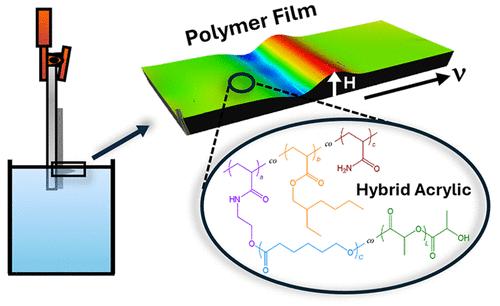定制混合丙烯酸聚合物的润湿脊动力学:机械特性对连续润湿的影响
IF 3.7
2区 化学
Q2 CHEMISTRY, MULTIDISCIPLINARY
引用次数: 0
摘要
本研究考察了由丙烯酸单体、丙烯酸化 l-内酯和ε-己内酯大单体(MMs)合成的各种接枝共聚物的润湿速度、聚合物机械性能以及由此产生的变形特性之间的关系。通过改变聚合物大单体(MMs)的组成,可以在对聚合物薄膜与水的静态接触角影响最小的情况下操纵聚合物薄膜的机械性能。研究的重点是粘滑行为开始前的润湿速度,在粘滑行为开始时,表面上会平滑地拉出脊线,从而产生瞬时变形,显示出波脉冲。传播脊结构的高度很快趋于稳定值,这取决于润湿速度和聚合物特性,与初始尺寸无关。结果表明,传播脊高度与润湿速度相关,数据与开尔文-沃依格特模型拟合良好,该模型产生了两个关键参数:零速度极限时的最大脊高度和特征润湿速度。这两个参数与 MM 中的内酯含量成线性关系,而特征润湿速度与聚合物流变主曲线的交叉频率成线性关系。此外,特征润湿速度还与从钢板上剥离聚合物薄膜所需的剥离力相关,从而在动态润湿和粘合行为之间建立了联系。我们的研究结果阐明了材料成分、机械性能和润湿行为之间的相互依存关系。这些见解为设计具有可控润湿性能的材料提供了巨大的潜力,尤其是在毛细管流动和表面相互作用起关键作用的应用领域。本文章由计算机程序翻译,如有差异,请以英文原文为准。

Tailoring Wetting Ridge Dynamics on Hybrid Acrylic Polymers: The Impact of Mechanical Properties on Continuous Wetting
This study examined the relationships among the wetting speed, the polymer mechanical properties, and the resulting deformation characteristics of various graft copolymers synthesized from acrylic monomers and acrylated l-lactide and ε-caprolactone macromonomers (MMs). The mechanical properties of the polymer films were manipulated with minimal impact on their static contact angles with water by varying their MM composition. The focus was on wetting speeds prior to the onset of stick–slip behavior, where ridges were smoothly pulled over the surfaces, thereby producing a transient deformation indicative of a wave pulse. The height of the propagated ridge structures quickly converged to a steady-state value, depending on the wetting speed and polymer properties, regardless of the initial size. The results show that the propagated ridge height correlates with the wetting speed, and the data are well fitted by the Kelvin–Voigt model, which yields two key parameters: the maximum ridge height at the limit of zero velocity and the characteristic wetting speed. Both parameters correlated linearly with the lactide content in the MMs, and the characteristic wetting speed correlated linearly with crossover frequencies from the rheological master curves of the polymers. Furthermore, the characteristic wetting speed was correlated with the peel force required to remove polymer films from the steel plates, establishing a connection between dynamic wetting and adhesive behavior. Our findings shed light on the interdependence between the material composition, mechanical properties, and wetting behavior. The insights presented offer significant potential for designing materials with controlled wetting properties, particularly for applications where capillary flow and surface interactions play critical roles.
求助全文
通过发布文献求助,成功后即可免费获取论文全文。
去求助
来源期刊

Langmuir
化学-材料科学:综合
CiteScore
6.50
自引率
10.30%
发文量
1464
审稿时长
2.1 months
期刊介绍:
Langmuir is an interdisciplinary journal publishing articles in the following subject categories:
Colloids: surfactants and self-assembly, dispersions, emulsions, foams
Interfaces: adsorption, reactions, films, forces
Biological Interfaces: biocolloids, biomolecular and biomimetic materials
Materials: nano- and mesostructured materials, polymers, gels, liquid crystals
Electrochemistry: interfacial charge transfer, charge transport, electrocatalysis, electrokinetic phenomena, bioelectrochemistry
Devices and Applications: sensors, fluidics, patterning, catalysis, photonic crystals
However, when high-impact, original work is submitted that does not fit within the above categories, decisions to accept or decline such papers will be based on one criteria: What Would Irving Do?
Langmuir ranks #2 in citations out of 136 journals in the category of Physical Chemistry with 113,157 total citations. The journal received an Impact Factor of 4.384*.
This journal is also indexed in the categories of Materials Science (ranked #1) and Multidisciplinary Chemistry (ranked #5).
 求助内容:
求助内容: 应助结果提醒方式:
应助结果提醒方式:


